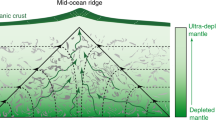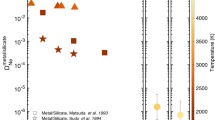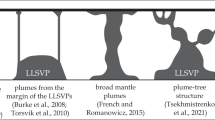Abstract
Several chemical models of mantle structure have been proposed1–6 based on isotopic data such as Sr, Nd, Hf and Pb in volcanic rocks from both oceanic and continental areas. The most popular of these are two chemical models of the vertically-layered mantle: (1) that it is a depleted mantle from which mid-oceanic ridge basalt (MORB) is derived and (2) that it is a fertile mantle from which a mantle plume may arise1–5. However, these models are almost always based on solid elements, such as Sr, Nd, Hf and Pb isotopes, and do not fully reflect the noble gas data. Because noble gases are liable to be lost from the solid earth when a mantle differentiation occurs on a global scale in the upper mantle, the data on noble gas isotopes could give constraints on the structure of the mantle that differ from those by solid element isotopes. Based on a consideration 3He/4He and 40Ar/36Ar ratios of recent samples, I argue here that the observed data suggest that mixing occurs between the source materials of a mantle plume and of MORB. The data seem to favour the model which assumes that the source of a typical mantle plume is deeper than that of MORB.
This is a preview of subscription content, access via your institution
Access options
Subscribe to this journal
Receive 51 print issues and online access
$199.00 per year
only $3.90 per issue
Buy this article
- Purchase on Springer Link
- Instant access to full article PDF
Prices may be subject to local taxes which are calculated during checkout
Similar content being viewed by others
References
Jacobsen, S. B. & Wasserburg, G. J. J. geophys. Res. 84, 7411 (1979).
O'Nions, R. K., Evensen, N. M. & Hamilton, P. J. J. geophys. Res. 84, 6091 (1979).
Tatsumoto, M. Earth planet. Sci. Lett. 38, 63 (1978).
Anderson, O. L. Earth planet. Sci. Lett. 57, 13 (1982).
Allègre, C. J., Brévart, O., Dupre, B. & Minster, J. F. Phil. Trans. R. Soc. A297, 447 (1980).
Davies, G. F. Nature 290, 208 (1981).
Jambon, A. & Shelby, J. E. Earth planet. Sci. Lett. 51, 206 (1980).
Kaneoka, I. & Takaoka, N. Science 208, 1366 (1980).
Kaneoka, I. & Takaoka, N. Abstr. 5th int. Conf. Geochronology, Cosmochronology, Isotope Geology (1982).
Craig, H. & Lupton, J. Earth planet. Sci. Lett. 31, 369 (1976).
Lupton, J. E., Weiss, R. F. & Craig, H. Nature 266, 244 (1977).
Kurz, M. D., Jenkins, W. J. & Hart, S. R. Nature 297, 43 (1982).
Nagao, K., Takaoka, N. & Matsubayashi, O. Earth planet. Sci. Lett. 53, 175 (1981).
Kyser, T. K. & Rison, W. J. geophys. Res. 87, 5611 (1982).
Tolstikhin, I. N. in Terrestrial Rare Gases (eds Alexander, E. C. Jr & Ozima, M.) (Center for Acadameic Publishing, Japan, 1978).
Author information
Authors and Affiliations
Rights and permissions
About this article
Cite this article
Kaneoka, I. Noble gas constraints on the layered structure of the mantle. Nature 302, 698–700 (1983). https://doi.org/10.1038/302698a0
Received:
Accepted:
Published:
Issue Date:
DOI: https://doi.org/10.1038/302698a0
This article is cited by
-
Extreme temporal homogeneity of helium isotopes at Piton de la Fournaise, Réunion Island
Nature (1990)
-
Nd–Sr–Pb isotope constraints on the sources of West Maui volcano, Hawaii
Nature (1986)
-
Hotspot magmas can form by fractionation and contamination of mid-ocean ridge basalts
Nature (1985)
-
Heat and helium in the Earth
Nature (1983)
Comments
By submitting a comment you agree to abide by our Terms and Community Guidelines. If you find something abusive or that does not comply with our terms or guidelines please flag it as inappropriate.



